What Is the Amount of China’s Building Floor Space from 1996 to 2014?
Abstract
1. Introduction
2. Literature Review
3. Systematic Analysis of the Deficiencies for the Items Concerning BFS in CSY
3.1. Statistical Caliber Inconsistency
3.2. Data Sources Inconsistency
3.3. Data Time Series Inconsistency
4. Methodology
4.1. Estimation Method for the Rural Residential Floor Space
4.2. Estimation Method for Urban Residential Floor Space
4.3. Estimation Method for Rural Commercial Floor Space
4.4. Estimation Method for Urban Commercial Floor Space
5. Results and Analysis
5.1. Characteristics of China’s Building Floor Space
5.2. Residential Building Floor Space
5.3. Commercial Building Floor Space
6. Reliability Analysis and Discussions
6.1. Reliability Analysis for Urban Residential and Commercial Building Floor Space
6.2. Reliability Analysis for Rural Residential and Commercial Building Floor Space
6.3. Discussion
7. Conclusions
- This study comprehensively analyzed the existing deficiencies regarding the BFS related statistical indicators in CSY and found that: (1) The statistical caliber on the TUBFS changed over time. (2) The floor space of completed suffers from a heterogeneous data source with great discrepancies. (3) Most of the statistical indicators suffer from incomplete time series data. (4) The data regarding urban commercial floor space cannot be obtained in CSY. (5) For urban residential building area, there is a big gap between the two statistical calibers.
- China BFS were estimated adopting the proposed method, and results indicated that China BFS was 61.3 billion m2 in 2014. Of this, commercial, urban residential and rural residential BFS were 10.3 billion m2, 26.5 billion m2 and 24.5 billion m2, respectively. Of China’s BFS in 2014, the urban residential BFS accounted for the largest proportion, 43.3%, like the percentage of the rural residential (40.0%), and the figure for the commercial building was the lowest, 16.8%.
- The total floor space in China witnessed an upward trend and increased by 33.2 billion m2 from 1996 to 2014, increasing about two times during this period. The average increase rate of the BFS in the whole period was 4.4% annually. During the period 1996–2014, three types of BFS saw various growth rates: 9.3% for the urban residential BFS and 4.4% and 1.6% for commercial and rural residential BFS, respectively. The rapid growth of the urban residential BFS contributed the most to the increase rate of the total BFS in China throughout the whole period.
- By comparing with the statistical data, we found that the deviations were well below 5%. This could indicate the reliability of the results and robustness of the proposed method.
Author Contributions
Funding
Acknowledgments
Conflicts of Interest
References
- Huo, T.; Li, X.; Cai, W.; Zuo, J.; Jia, F.; Wei, H. Exploring the impact of urbanization on urban building carbon emissions in China: Evidence from a provincial panel data model. Sustain. Cities Soc. 2020, 56, 102068. [Google Scholar] [CrossRef]
- Mi, Z.; Meng, J.; Guan, D.; Shan, Y.; Song, M.; Wei, Y.-M.; Liu, Z.; Hubacek, K. Chinese CO2 emission flows have reversed since the global financial crisis. Nat. Commun. 2017, 8, 1–10. [Google Scholar] [CrossRef] [PubMed]
- IPCC. IPCC Fifth Assessment Synthesis Report-Climate Change 2014 Synthesis Report. In IPCC Fifth Asses; Report-Climate Change: Geneva, Switzerland, 2014; p. 167. [Google Scholar]
- IEA. World Energy Outlook 2013, International Energy Agency. Available online: https://doi.org/10.1787/20725302 (accessed on 20 June 2013).
- BP. Statistical Review of World Energy. Available online: http://www.indiaenvironmentportal.org.in/content/444050/bp-statistical-review-of-world-energy-2017/ (accessed on 20 April 2017).
- Huo, T.; Ren, H.; Zhang, X.; Cai, W.; Feng, W.; Zhou, N.; Wang, X. China’s energy consumption in the building sector: A Statistical Yearbook-Energy Balance Sheet based splitting method. J. Clean. Prod. 2018, 185, 665–679. [Google Scholar] [CrossRef]
- Zhou, N.; Lin, J. The reality and future scenarios of commercial building energy consumption in China. Energy Build. 2008, 40, 2121–2127. [Google Scholar] [CrossRef]
- Sun, C.; Ouyang, X.; Cai, H.; Luo, Z.; Li, A. Household pathway selection of energy consumption during urbanization process in China. Energy Convers. Manag. 2014, 84, 295–304. [Google Scholar] [CrossRef]
- Du, G.; Sun, C.; Ouyang, X.; Zhang, C. A decomposition analysis of energy-related CO2 emissions in Chinese six high-energy intensive industries. J. Clean. Prod. 2018, 184, 1102–1112. [Google Scholar] [CrossRef]
- Huo, T.; Cai, W.; Ren, H.; Feng, W.; Zhu, M.; Lang, N.; Gao, J. China’s building stock estimation and energy intensity analysis. J. Clean. Prod. 2019, 207, 801–813. [Google Scholar] [CrossRef]
- Huo, T.; Ren, H.; Cai, W. Estimating urban residential building-related energy consumption and energy intensity in China based on improved building stock turnover model. Sci. Total. Environ. 2019, 650, 427–437. [Google Scholar] [CrossRef]
- Zhang, Y.; Peng, H.; Su, B. Energy rebound effect in China’s Industry: An aggregate and disaggregate analysis. Energy Econ. 2017, 61, 199–208. [Google Scholar]
- UNDESA. World Urbanization Prospects the 2011 Revision; United Nations: New York, NY, USA, 2012; p. 318. [Google Scholar]
- Feng, C.; Huang, J.B.; Wang, M. The driving forces and potential mitigation of energy-related CO2 emissions in China’s metal industry. Resour. Policy 2018, 59, 487–494. [Google Scholar] [CrossRef]
- Wang, M.; Feng, C. Exploring the driving forces of energy-related CO2 emissions in China’s construction industry by utilizing production-theoretical decomposition analysis. J. Clean. Prod. 2018, 202, 710–719. [Google Scholar] [CrossRef]
- Zhang, W.; Jiang, L.; Cui, Y.; Xu, Y.; Wang, C.; Yu, J.; Streets, D.G.; Lin, B. Effects of urbanization on airport CO2 emissions: A geographically weighted approach using nighttime light data in China. Resour. Conserv. Recycl. 2019, 150, 104454. [Google Scholar] [CrossRef]
- Zuo, J.; Xia, B.; Barker, J.; Skitmore, M.; Skitmore, M. Green buildings for greying people: A case study of a retirement village in Australia. Facilities 2014, 32, 365–381. [Google Scholar] [CrossRef]
- Zhang, X. Toward a regenerative sustainability paradigm for the built environment: from vision to reality. J. Clean. Prod. 2014, 65, 3–6. [Google Scholar] [CrossRef]
- Huo, T.; Tang, M.; Cai, W.; Ren, H.; Liu, B.; Hu, X. Provincial total-factor energy efficiency considering floor space under construction: An empirical analysis of China’s construction industry. J. Clean. Prod. 2020, 244, 118749. [Google Scholar] [CrossRef]
- Zhang, W.; Lu, Z.; Xu, Y.; Wang, C.; Gu, Y.; Xu, H.; Streets, D.G. Black carbon emissions from biomass and coal in rural China. Atmos. Environ. 2018, 176, 158–170. [Google Scholar] [CrossRef]
- Zuo, J.; Zhao, Z.-Y. Green building research—Current status and future agenda: A review. Renew. Sustain. Energy Rev. 2014, 30, 271–281. [Google Scholar] [CrossRef]
- Zhang, X.; Zhao, X.; Jiang, Z.; Shao, S. How to achieve the 2030 CO2 emission-reduction targets for China’s industrial sector: Retrospective decomposition and prospective trajectories. Glob. Environ. Chang. 2017, 44, 83–97. [Google Scholar] [CrossRef]
- Yuan, X.; Zuo, J. Transition to low carbon energy policies in China—From the Five-Year Plan perspective. Energy Policy 2011, 39, 3855–3859. [Google Scholar] [CrossRef]
- NBSC. China Statistical Yearbook 2016; China Statistics Press: Beijing, China, 2016. [Google Scholar]
- Hong, L.; Zhou, N.; Feng, W.; Khanna, N.; Fridley, D.; Zhao, Y.; Sandholt, K. Building stock dynamics and its impacts on materials and energy demand in China. Energy Policy 2016, 94, 47–55. [Google Scholar] [CrossRef]
- Zhao, D.; McCoy, A.P.; Du, J.; Agee, P.; Lu, Y. Interaction effects of building technology and resident behavior on energy consumption in residential buildings. Energy Build. 2017, 134, 223–233. [Google Scholar] [CrossRef]
- Zhao, D.; McCoy, A.P.; Du, J. An empirical study on the energy consumption in residential buildings after adopting green building standards. Procedia Eng. 2016, 145, 766–773. [Google Scholar] [CrossRef]
- Vásquez, F.; Løvik, A.N.; Sandberg, N.H.; Müller, D.B. Dynamic type-cohort-time approach for the analysis of energy reductions strategies in the building stock. Energy Build. 2016, 111, 37–55. [Google Scholar] [CrossRef]
- Zhao, W.; Leeftink, R.; Rotter, V.S. Evaluation of the economic feasibility for the recycling of construction and demolition waste in China—The case of Chongqing. Resour. Conserv. Recycl. 2010, 54, 377–389. [Google Scholar] [CrossRef]
- Zhang, Y.-J.; Hao, J.-F.; Song, J. The CO2 emission efficiency, reduction potential and spatial clustering in China’s industry: Evidence from the regional level. Appl. Energy 2016, 174, 213–223. [Google Scholar] [CrossRef]
- Yang, X.; Jiang, Y. Comparison of energy consumption between Chinese and foreign buildings. Research 2007, 6, 21–26. [Google Scholar]
- Tso, G.K.; Guan, J.; Tso, G. A multilevel regression approach to understand effects of environment indicators and household features on residential energy consumption. Energy 2014, 66, 722–731. [Google Scholar] [CrossRef]
- Kialashaki, A.; Reisel, J.R. Development and validation of artificial neural network models of the energy demand in the industrial sector of the United States. Energy 2014, 76, 749–760. [Google Scholar] [CrossRef]
- Kelly, S. Do homes that are more energy efficient consume less energy? A structural equation model of the English residential sector. Energy 2011, 36, 5610–5620. [Google Scholar] [CrossRef]
- Kavousian, A.; Rajagopal, R.; Fischer, M. Determinants of residential electricity consumption: Using smart meter data to examine the effect of climate, building characteristics, appliance stock, and occupants’ behavior. Energy 2013, 55, 184–194. [Google Scholar] [CrossRef]
- Hu, M.; Van Der Voet, E.; Huppes, G. Dynamic material flow analysis for strategic construction and demolition waste management in Beijing. J. Ind. Ecol. 2010, 14, 440–456. [Google Scholar] [CrossRef]
- Clune, S.; Morrissey, J.; Moore, T. Size matters: House size and thermal efficiency as policy strategies to reduce net emissions of new developments. Energy Policy 2012, 48, 657–667. [Google Scholar] [CrossRef]
- Cai, W.; Wu, Y.; Zhong, Y.; Ren, H. China building energy consumption: Situation, challenges and corresponding measures. Energy Policy 2009, 37, 2054–2059. [Google Scholar] [CrossRef]
- Müller, D.B. Stock dynamics for forecasting material flows—Case study for housing in The Netherlands. Ecol. Econ. 2006, 59, 142–156. [Google Scholar] [CrossRef]
- Pauliuk, S.; Arvesen, A.; Stadler, K.; Hertwich, E.G. Industrial ecology in integrated assessment models. Nat. Clim. Chang. 2017, 7, 13–20. [Google Scholar] [CrossRef]
- Moura, M.C.P.; Smith, S.J.; Belzer, D.B. 120 years of U.S. residential housing stock and floor space. PLoS ONE 2015, 10, e0134135. [Google Scholar] [CrossRef] [PubMed]
- Hu, M.; Bergsdal, H.; Van Der Voet, E.; Huppes, G.; Müller, D.B. Dynamics of urban and rural housing stocks in China. Build. Res. Inf. 2010, 38, 301–317. [Google Scholar] [CrossRef]
- Zhou, N.; Fridley, D.; Khanna, N.Z.; Ke, J.; McNeil, M.; Levine, M. China’s energy and emissions outlook to 2050: Perspectives from bottom-up energy end-use model. Energy Policy 2013, 53, 51–62. [Google Scholar] [CrossRef]
- Yang, T.; Pan, Y.; Yang, Y.; Lin, M.; Qin, B.; Xu, P.; Huang, Z. CO2 emissions in China’s building sector through 2050: A scenario analysis based on a bottom-up model. Energy 2017, 128, 208–223. [Google Scholar] [CrossRef]
- McNeil, M.A.; Letschert, V.E.; Stephane, R.C.; Ke, J. Bottom-Up Energy Analysis System—Methodology and Results; Lawrence Berkeley National Laboratory: Berkeley, CA, USA, 2012. [Google Scholar]
- Jiang, Y.; Yang, X. China BEC situation and the problems existing in the energy conservation works. China Constr. 2006, 2006, 12–13. [Google Scholar]
- Fridley, D.; Zheng, N.; Zhou, N. Estimating Total Energy Consumption and Emissions of China’s Commercial and Office Buildings; Office of Scientific & Technical Information Technical Reports: Berkeley, CA, USA, 2008. [Google Scholar]
- NBSC. China Statistical Yearbook; China Statistics Press: Beijing, China, 2013. [Google Scholar]
- NBSC. China Statistical Yearbook; China Statistics Press: Beijing, China, 2007. [Google Scholar]
- MOHURD. China Urban.-Rural Construction Statistical Yearbook; China Planning Press: Beijing, China, 2016. [Google Scholar]
- Wu, Y.; Shen, J.; Zhang, X.; Skitmore, M.; Lu, W. Reprint of: The impact of urbanization on carbon emissions in developing countries: a Chinese study based on the U-Kaya method. J. Clean. Prod. 2017, 135, 589–603. [Google Scholar] [CrossRef]
- Song, J. Migrant employment in urban China: Characteristics and determinants-a comparative study with rural left-behind people. Population 2012, 34, 32–42. [Google Scholar]
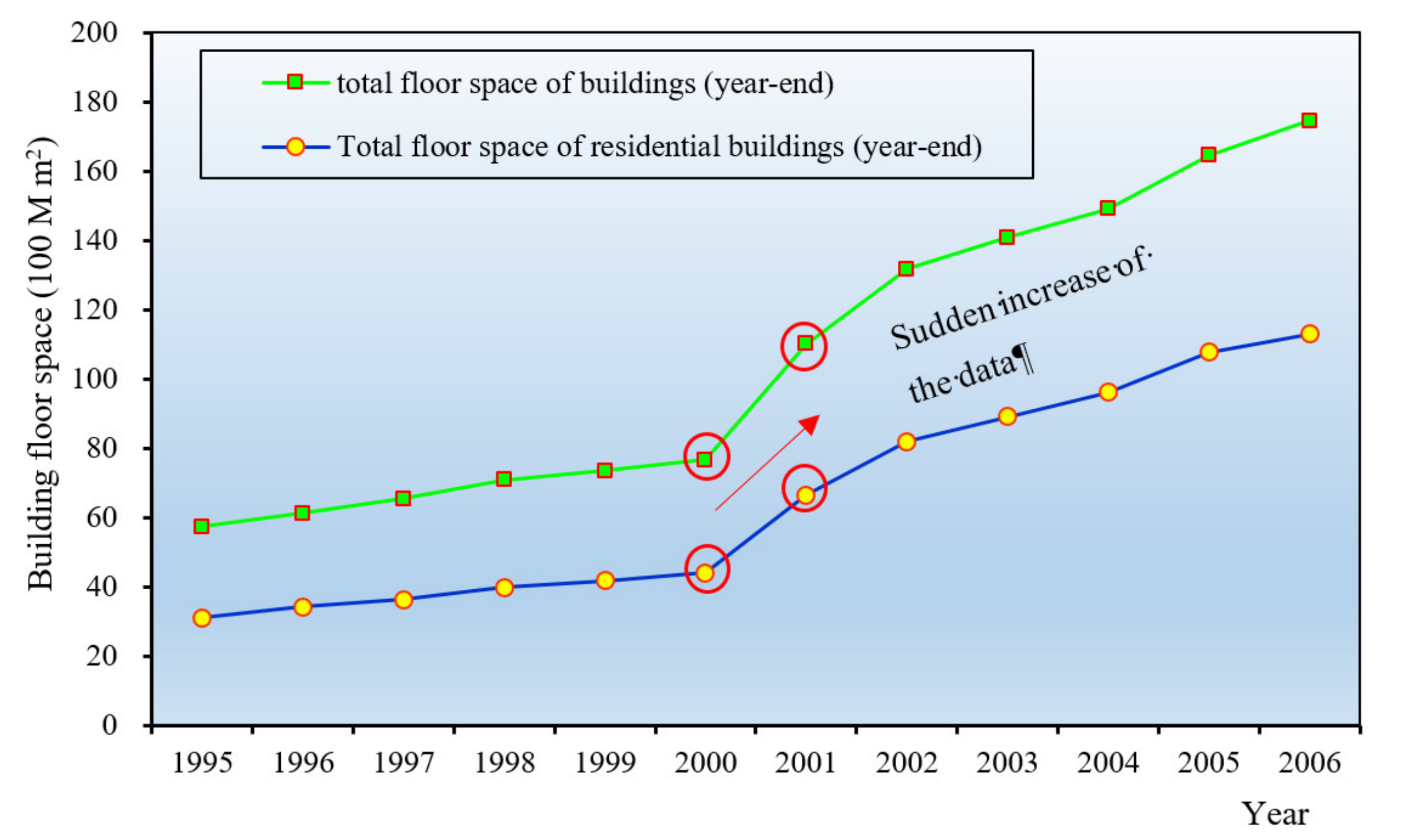
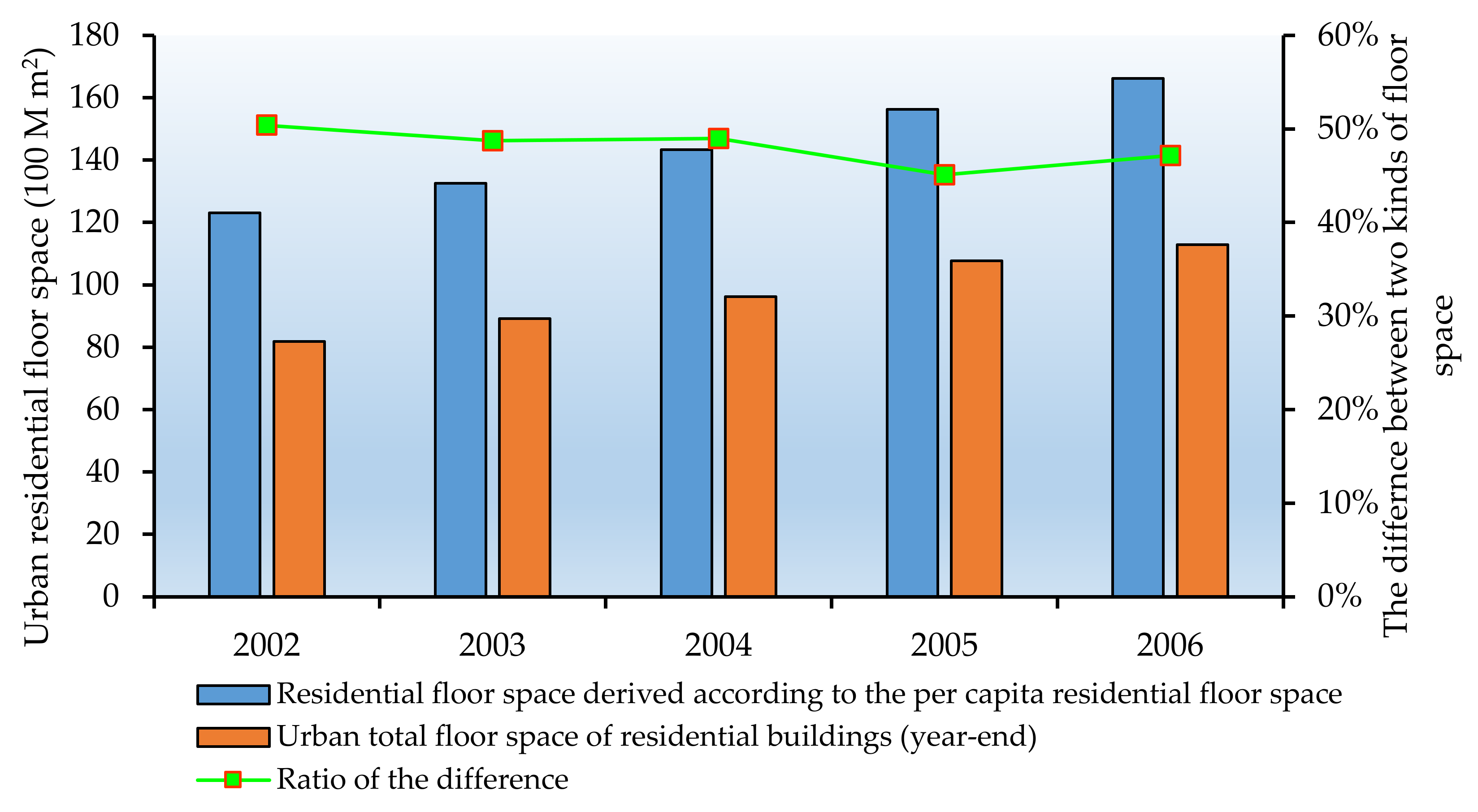
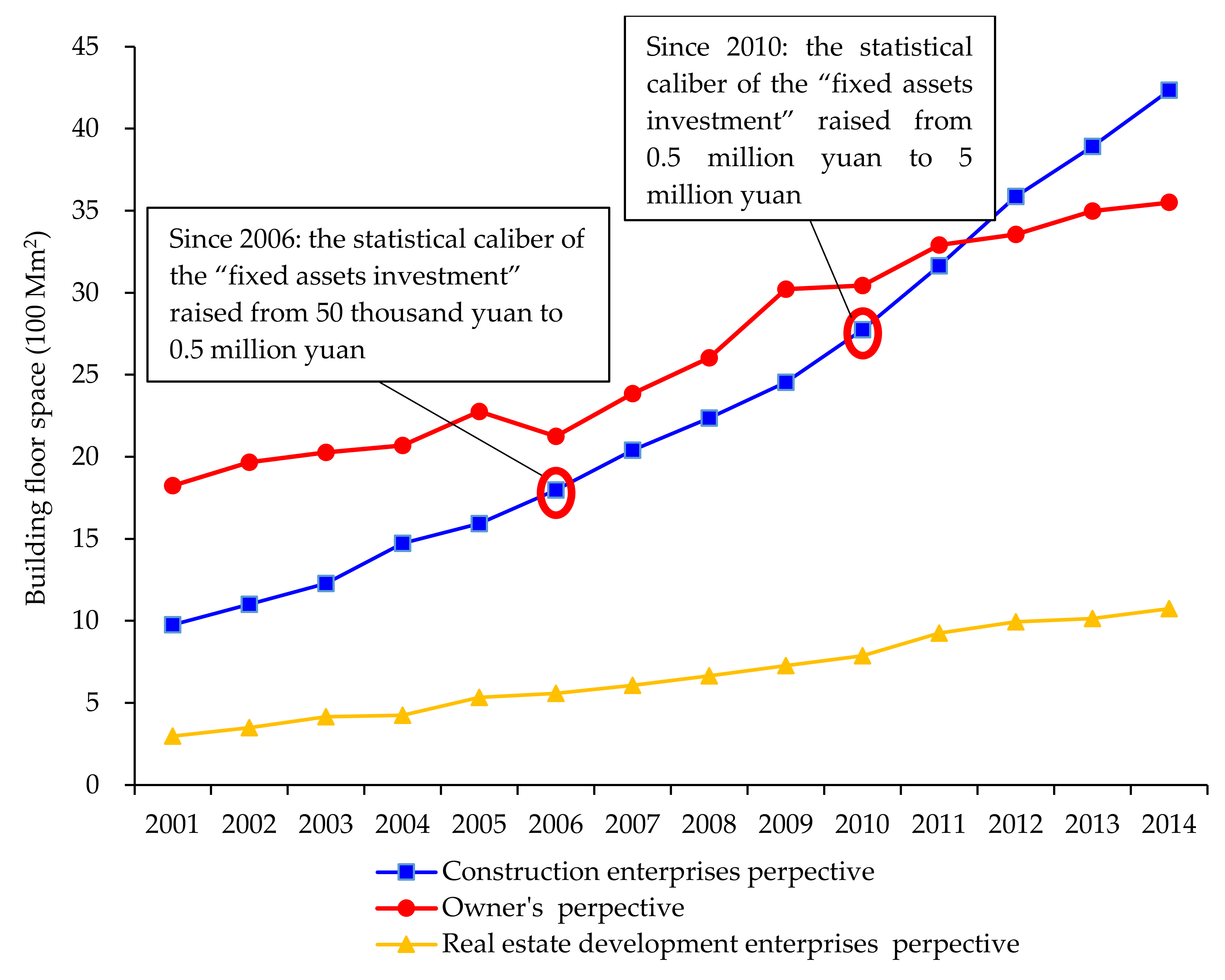
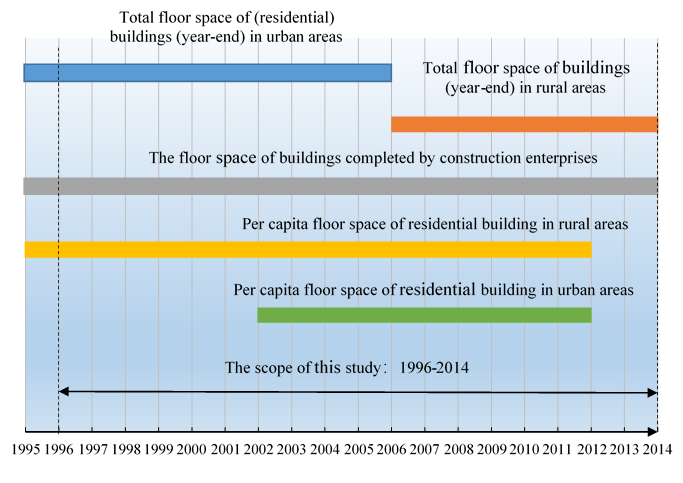
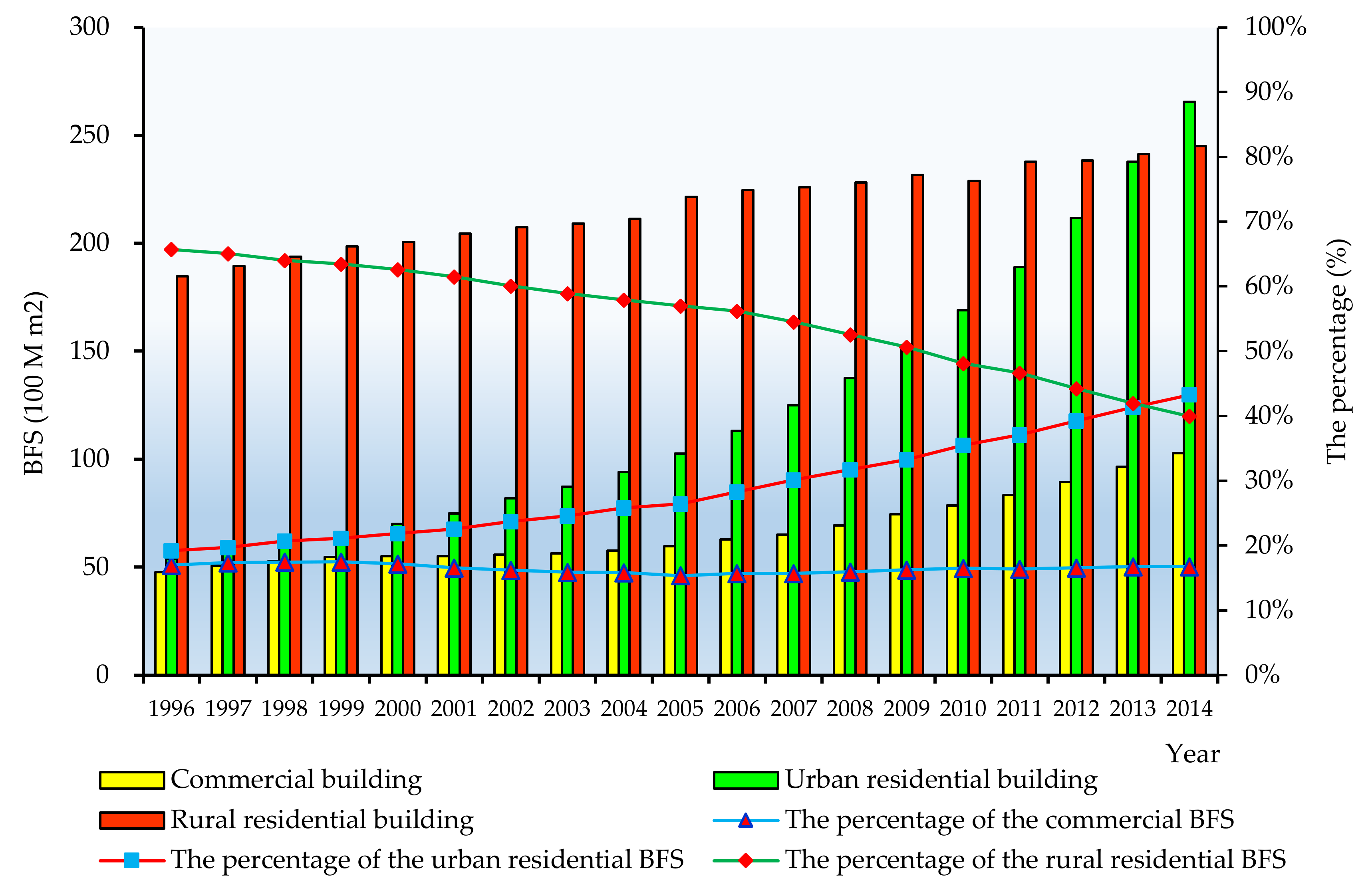
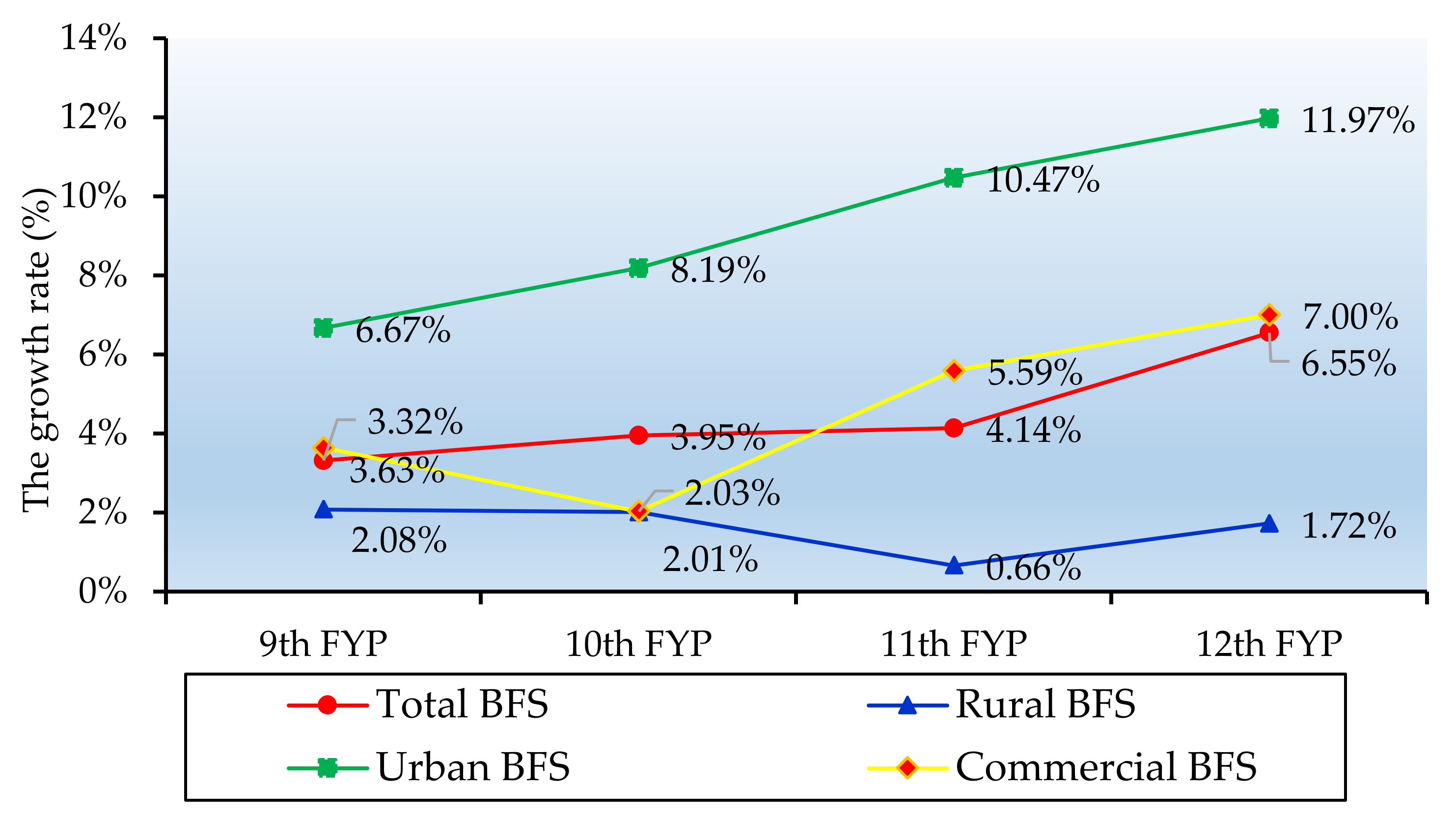
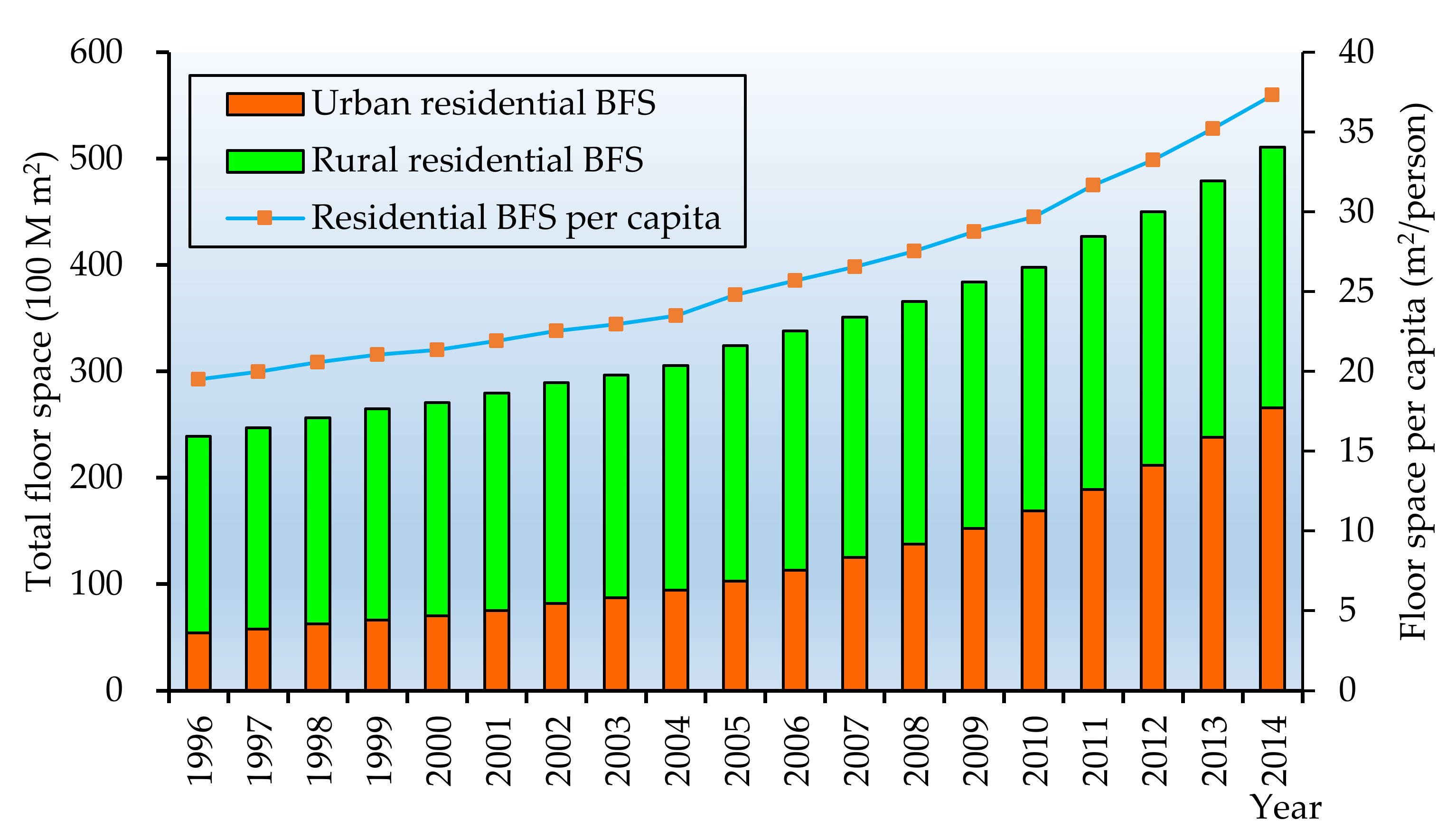
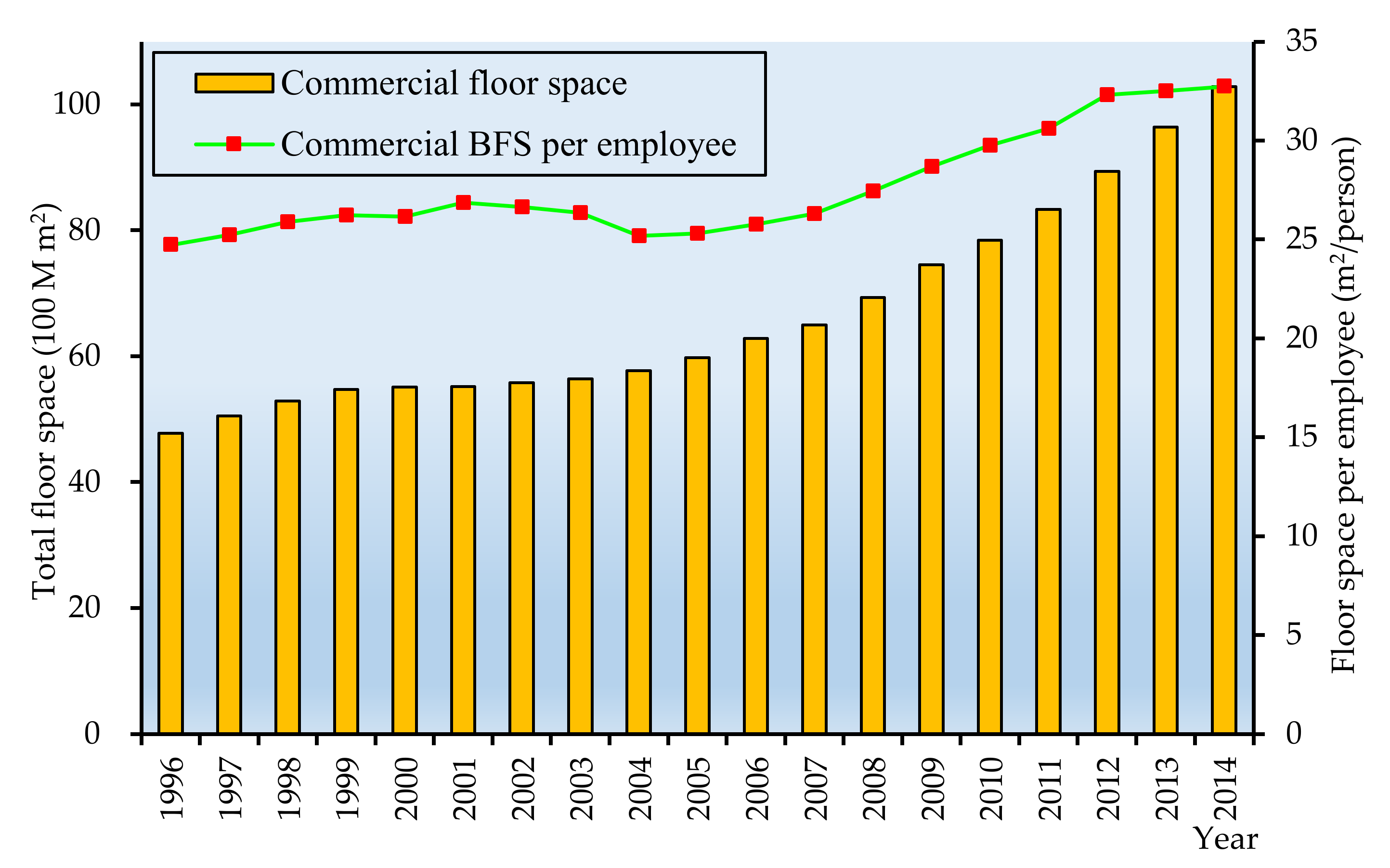
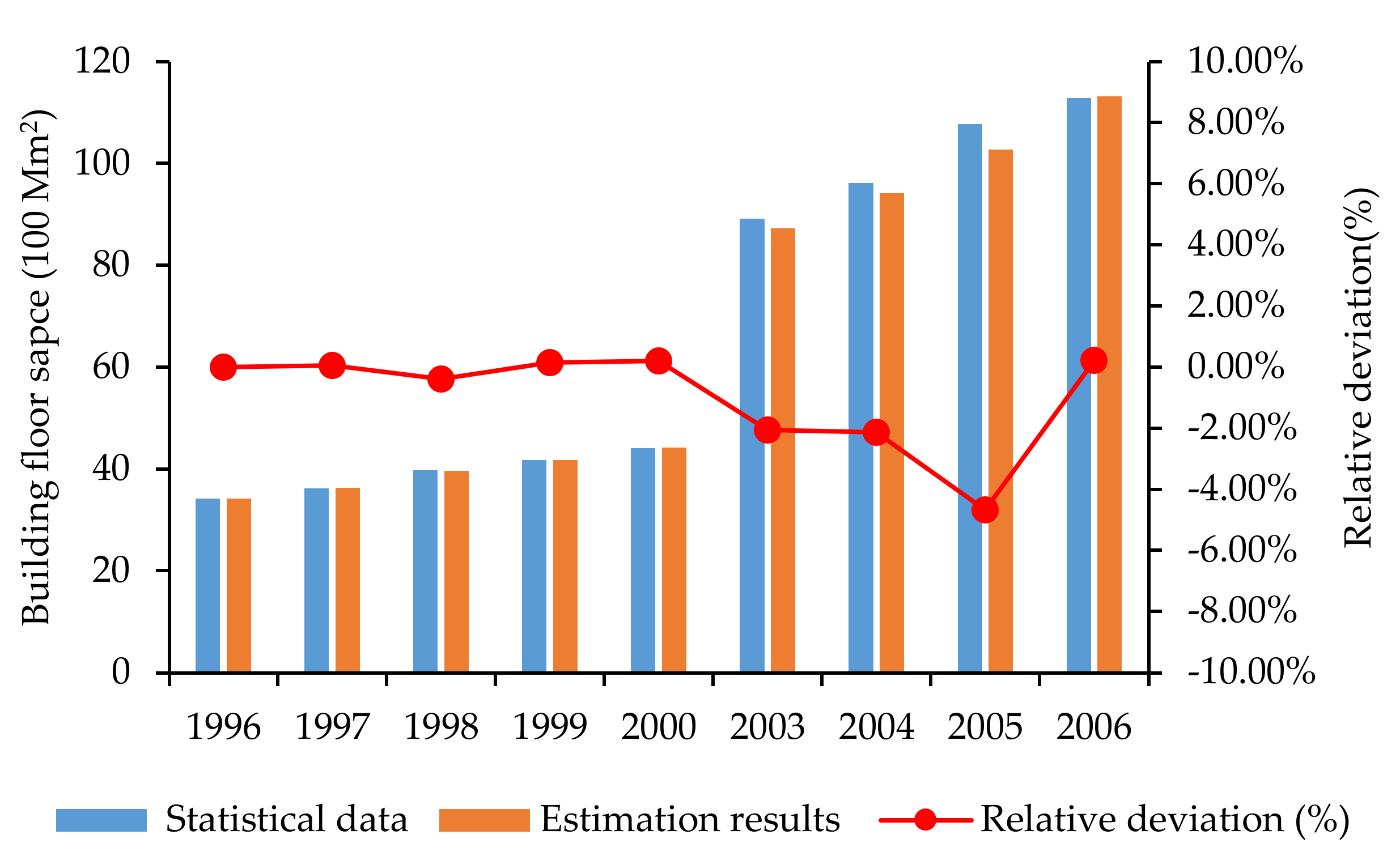
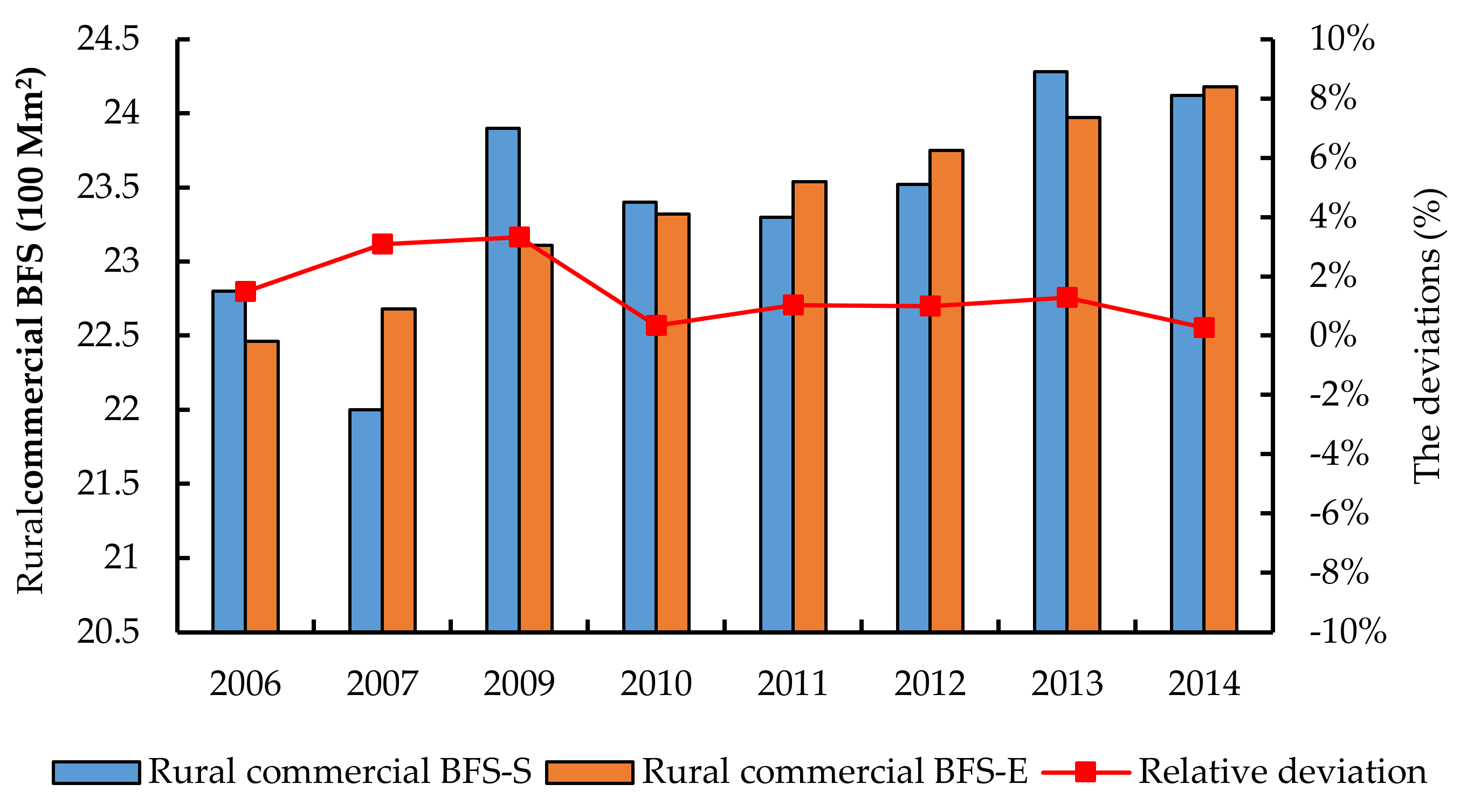
© 2020 by the authors. Licensee MDPI, Basel, Switzerland. This article is an open access article distributed under the terms and conditions of the Creative Commons Attribution (CC BY) license (http://creativecommons.org/licenses/by/4.0/).
Share and Cite
Pan, L.; Zhu, M.; Lang, N.; Huo, T. What Is the Amount of China’s Building Floor Space from 1996 to 2014? Int. J. Environ. Res. Public Health 2020, 17, 5967. https://doi.org/10.3390/ijerph17165967
Pan L, Zhu M, Lang N, Huo T. What Is the Amount of China’s Building Floor Space from 1996 to 2014? International Journal of Environmental Research and Public Health. 2020; 17(16):5967. https://doi.org/10.3390/ijerph17165967
Chicago/Turabian StylePan, Linwei, Minglei Zhu, Ningning Lang, and Tengfei Huo. 2020. "What Is the Amount of China’s Building Floor Space from 1996 to 2014?" International Journal of Environmental Research and Public Health 17, no. 16: 5967. https://doi.org/10.3390/ijerph17165967
APA StylePan, L., Zhu, M., Lang, N., & Huo, T. (2020). What Is the Amount of China’s Building Floor Space from 1996 to 2014? International Journal of Environmental Research and Public Health, 17(16), 5967. https://doi.org/10.3390/ijerph17165967




